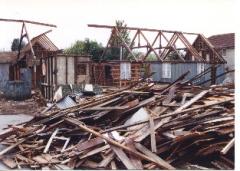Navigation
go to St Columba details

Origins
of St. Columba's Church (which became the '106 Club ')
- 1891 St. Columba's Church opens (the 'Tin Tabernacle')
- 1906 Church extended (Chancel added)
- 1963 Church becomes the '106 Club'
- 1979 106 Club closes
- 1992 Building demolished
ST. COLUMBA CHURCH, CATISFIELD, 1891 TO 1991
A History of the Church. by Maureen Sygrove, May 1991
Victorian England saw many ‘Tin Tabernacles’ built all over the country and in 1891 William Thresher, a retired naval Commander and one time Churchwarden of Holy Trinity, was instrumental in building one, as a mission chapel dedicated to St. Columba in Catisfield Lane. A Deed conveying the land from Montague Foster of Stubbington House is dated 2nd November 1906 but refers to another dated 31st December 1890. The land came from the Limes estate owned in 1906 by Mrs Holliday. The Chapel opened In 1891 and officially on St. Columba Day 9th June 1892 with a 7pm service attended by more than 130 people.
The land conveyed was to be used for a Church, classroom, or meeting place for Catisfield or sold at a future date for the purchase of a new building. The Deed conveyed it to the Trustees of the Winchester Diocesan Trust Deed and local trustees, Rev. Arnold, Vicar of Holy Trinity, William Thresher of Avenue End and Mrs. Matthias of Catisfield Lodge.
1906: The original small building was enlarged and a Chancel added in 1906, the Trustees ad Mrs. Napier of Catisfield Cottage being largely responsible. The building, though of corrugated iron outside was wood lined with arched windows and with a small wooden spire over its bell tower. It was 1oved and cared for by many local people, most notably the families of Mrs. Edney and Mrs. Lock who lived in cottages opposite, Mrs Privett and Mr Goodall.
The Chapel had a Choir from its earliest days, boys and men only, possibly in black robes, at first then with Women and without robes arid finally in purple. Services seem to have varied but Harvest Festivals and Christmas were always well attended and a Sunday afternoon service started early. In 1893 8am Communion and Evensong at 6-30 (3-30 in the winter months) started and in 1907 Matins. Occasional services of Preparation for Holy Communion, Churchings, Baptism and Mothers' Union are recorded and in 1917 the first noted childrens service. Special prayers were also said on 21st August 1914 and to dedicate the Roll of Honour on 30th January 1920.
In 1893 there was obviously a request to separate from Holy Trinity as Mrs Kirby, the Patroness "declined to assent". She hoped to hear nothing further of the matter. In 1923 Miss Matthias reminded the PCC that her elderly mother was the last remaining Trustee and a decision was made to make the Vicar and Churchwardens of Holy Trinity Trustees, breaking the local link. Captain Thresher’s bequest of £105 for the "exclusive benefit of St Columba" was also used to raise the stipend of the Holy Trinity living by £20 a year "as long as Catisfield remained part of the undivided parish".
The interior of the Church was steadily improved with gifts, many anonymous. In 1924 an Oak Chair and footstool was given by Rev Charles Arnold, an original Trustee, and in 1925 a Priest's desk by Rev. W. Spencer, curate in charge. In 1934 a stained glass window in memory of Mrs Ellin Napier was dedicated. From this window the Dove in the new St. Columba was taken. The Church had a harmonium, played by Miss Fynney which was repaired in 1926, a bell, rung for all services, and was obviously well cared for and popular from surviving photographs.
By ‘ 1939 there was a flourishing Sunday School and "The Guild" held services in 1942 at 3pm, only to vanish in1945. After the war Catisfield changed rapidly as new estates appeared and the Church congregation expanded rapidly.
An organ was fitted in 1948 and the Church painted, presumably from red to green, in 1956 by Freemantles.
Six trees, probably Horse Chestnuts, were removed after being pollarded for several years also in 1956, as they were undermining walls. In 1957 the wooden bell tower, now rotten., was removed and a fine Ship Weathervane, given by HMS Collingwood. Was erected, probably through Commander Ouvry and remembering Captain Thresher "Father Christmas" of Catisfield
Celebration of St. Columba Patronal Festival was first recorded in 1955 when Rev. Norman Crowder officiated. Services had now settled at 8am Communion (12 noon on the first Sunday). 10am Childrens service or Sunday School, 11am Mattins and 3-30 or 6-30 Evensong with special services in addition. The original Sunday School met in a hut built by the Matthias family on Catisfield Lodge land roughly where Highlands Road crossed to the A27 in l966. It moved to the Church and the Memorial Hall after 1948. Mrs Young, Mrs Lawrence and Mrs Highland were the principal leaders, helped by many others including Justina Gardner, a member of the St. Columba choir. Social events such as Garden Parties and Harvest Suppers took place at the grand houses such as Catisfield House until the Hall was built.
By February 1956 St Columba had its own page in the Parish Magazine and the choir was led by Mrs Glenister. The Catisfield Guild existed again and in 1957 agreed to meet monthly. In that year too a Family Fellowship started. The Church was also responsible for administering the O'Bryen Charity of free coal for needy Catisfield residents. The Bishop of Portsmouth preached in the Church on 11th November 1956 when his Chaplain Rev. Norman Crowder was unwell. The Church had never had its own clergymen but now usually had a Holy Trinity curate more surely assigned to it.
The growing congregation was notably augmented by the "mustard" or "Custard" tops of Lysses House boarding School. The boys walked in crocodile from the School (now the Heath-field) for morning service. The Church was also connected with the new Catisfield and District Horticultural Society which held its first Show in the Summer of 1959. The Church is remembered by many for its splendid Harvest Festivals.
The leaders of the little Church in its last years were the Secretary, Mr W J Shaw. Organist Mrs Glenister, Caretaker Mrs Edney and in 1959 Treasurer Mr Nash, who administered the Duplex envelope scheme in Catisfield. New members made the Church too small and a decision was made to build a new St Columba as a Mission among the new estates. Sunday Schools were by the late 1950s held in Fareham Park School and the WI Hut in Oak Road as well as the Church. Rev. David Maurice became the first Priest in Charge of St. Columba and saw through the move to the new site.
The '106' CLUB, CATISFIELD, 1963 - 1979
1963 In May Mr Dicky Downes bought the deconsecrated Tin Tabernacle, St Columba, built in 1891. Later that year he opened the building as the 106 Country Club. Rather than have two Country Clubs, he changed the Limes into a hotel and pub. He gave the ownership of the 106 Club to daughter Daphne and her brother, Richard. equally, though Mr Downes continued to run the club.
1979. The '106' Club closed. The running had been leased to a Hugh Curtis. The standards of the club had deteriotated. Richard and Daphne discussed stepping in to run it themselves 'under new management’, but they couldn’t agree, and as they were equal partners, the club closed
Images
NB 'Maxi-Enlarge'
shows a very large image - may not be available on-line due to size.
The 'Tin
Tabernacle' as it was
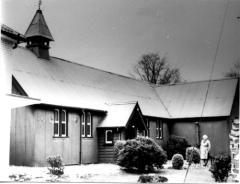
Enlarge picture..
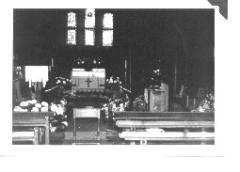
Enlarge picture..
.
For MORE pictures of St Columba as it was,
go to:
StColumbaEarlyPicturesalbum.html..
The
'Tin Tabernacle' in its last days (1991)
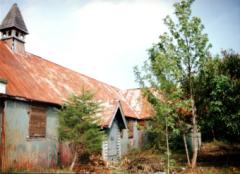
From the West Enlarge picture..
Maxi-Enlarge picture..
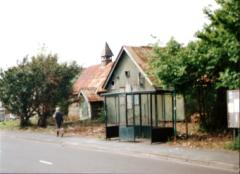 From the East Enlarge picture..
Maxi-Enlarge picture..
From the East Enlarge picture..
Maxi-Enlarge picture..
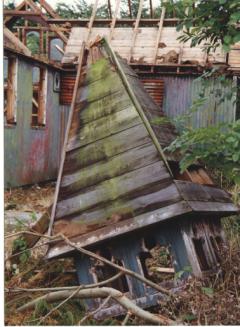
Enlarge picture..
1992: The End - the belfrey goes. And then there's nothing.
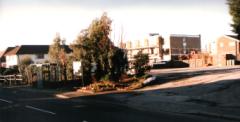
The site
where the church was, 1999. (Catisfield (Hinton) Hotel in the background)
Enlarge picture..
Maxi-Enlarge picture..
For
MORE pictures of St Columba as it was before and during demolition, go
to:
StColumbaEndPictures.html
The
above history of St. Columba comes from a leaflet written for Holy Trinity.
There
may be slightly updated information on their website, eg:
http://www.holytrinitystcolumba.org.uk/stcolumba_history.html
http://www.holytrinitystcolumba.org.uk/columba.html
and
there is also a list there of the clergy:
http://www.holytrinitystcolumba.org.uk/stcolumba_clergy.html
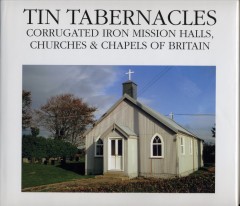 If
you are interested in 'Tin Tabernacles' there is an interesting
book describing 200+ examples - including Catisfield's St. Columba.
If
you are interested in 'Tin Tabernacles' there is an interesting
book describing 200+ examples - including Catisfield's St. Columba.
by
Ian Smith, Published by Camrose Organisation. 2004 ISBN 0-9547126-0-9
Tin Chapels Project, Camrose Organisation, Camrose House, 106 Main Street
Pembroke SA71 4HN, UK
see also: http://www.tintabernacles.com/
